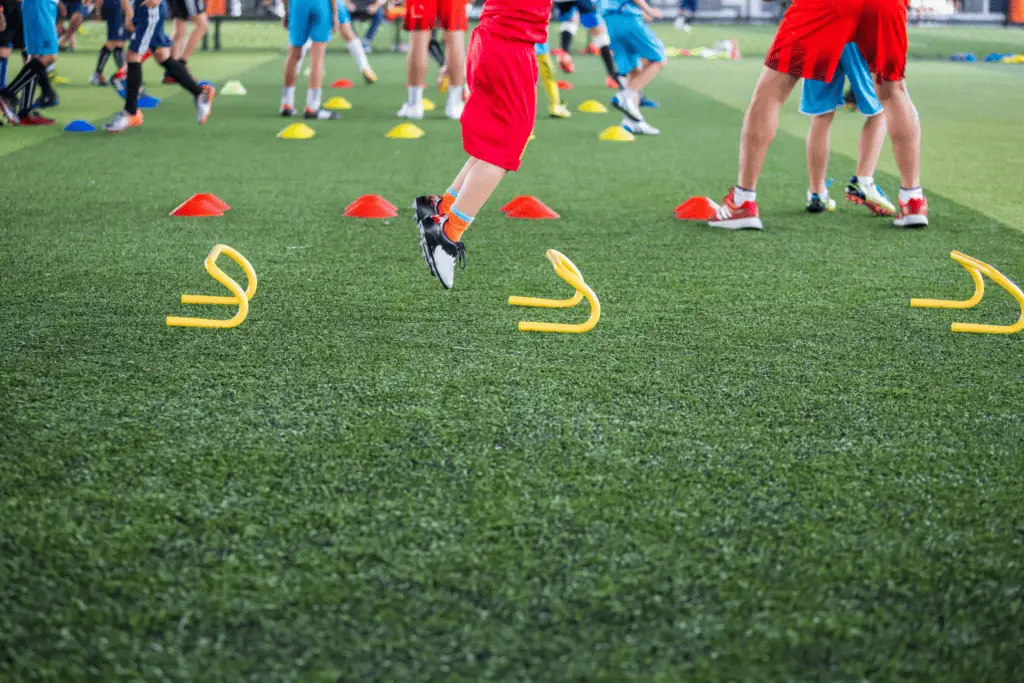Physical soccer training is one of the three types of soccer practice. It’s the type that players dread the most because it involves conditioning and fitness drills, usually accompanied by agility ladders.
Physical soccer training is a type of training where players improve fitness levels through various exercises, including short sprints, long-distance running, agility ladders, and shuttle runs. These soccer-oriented drills improve players’ fitness levels in preparation for an upcoming game or season.
Physical soccer training is most common during preseason (or perhaps after a tough loss). Let’s talk more about this type of training and how physical soccer training is different from tactical and technical training.
Table of Contents
What is physical soccer training?
Soccer requires you to be in great physical shape. Physical soccer training can help you take your game to the next level.
Physical soccer training is a way to improve your soccer fitness and your ability to move around the field effectively over the course of a game. This type of training includes conditioning and agility drills with an emphasis on soccer movements, including short sprints and ladder drills.
Physical soccer training does not require a soccer ball, but you can use one to incorporate conditioning into passing and finishing drills. Simulating game-like movements and intensity during training improves your speed of play and quality during games.

You can do physical soccer training on your own or with your team. You can even do it after a technical or tactical training session. I recommend physical soccer training when you’re out of season or days ahead of a game.
A good example of physical soccer training is two-a-days or preseason camps, where teams get together before the season to go through rigorous training sessions. These physical trainings are often paired with the other two types of training; tactical and technical.
Improving your fitness and getting into “soccer shape”
Improving fitness for soccer is a critical aspect of player development. It complements your technical skillset and is the foundation of your ability as a player.
Getting into “soccer shape” means training to become fitter for soccer. This includes conditioning drills combining short sprints with long runs and ladders to improve agility. These are things that will get you into soccer shape.
These training types improve your fitness for soccer games. Incorporate them into your training regimen alongside tactical and technical practices.
Physical soccer training is one of the easiest ways to train for soccer by yourself. Sprints, agility ladders, and long-distance running can all be done solo or with a group of people.
Physical training vs. tactical training
Physical soccer training is one of the three types of soccer training. It’s especially different from tactical training.
Physical soccer training improves fitness levels through various conditioning exercises. Tactical training, however, discusses team strategy and tactics for games. Coaches implement tactical training sessions weekly or biweekly for planning and strategizing. Neither of these training types requires a soccer ball.
Tactical training is team-oriented but helps improve individual soccer awareness, intelligence, and vision of the game.
Tactical training is most commonly done in a team setting using whiteboards to cover potential game scenarios. It also includes film sessions where teams watch films of past games or of another team they’re about to play against.
You can practice tactical training by brushing up on general soccer knowledge or watching yourself on film.
Physical training vs. technical training
Physical soccer training is different from technical soccer training. Each ultimately improves fitness levels, but that’s not all technical soccer practice is about.
Technical soccer training develops a player’s individual soccer skills through various on-the-ball exercises, including passing, finishing, defending, and goalkeeping drills. Physical soccer training uses conditioning activities to improve fitness levels. Technical training requires a soccer ball, but physical soccer training does not.
Technical soccer training is the most common type of soccer training. If you want to improve at soccer, start with this type of session and perform drills and exercises with a ball. You can do these by yourself or with a partner, small group, or team.
When we think of normal soccer practice, we’re referring to technical soccer training. Specialized training, like tactical training, focuses more on team strategy and tactic formulation per the coach’s discretion and the team’s goals.
Physical soccer training can be intertwined with technical training during high-intensity on-the-ball drills. Fast pace training technical training sessions improve fitness levels and simulate game-like situations; a win-win for soccer players.
| Tactical | Physical | Technical |
|---|---|---|
| Develop a greater understanding of the sport | Increase overall fitness levels | Develop skills (dribbling, shooting, passing, ball control, etc.) |
| Discuss team-oriented strategy and tactics | Can incorporate soccer balls to simulate game-like scenarios | Become a better all-around player |
| Review past game films to address mistakes and bad habits | Shorter; can be added onto the end of another type of training | Build chemistry with teammates |
